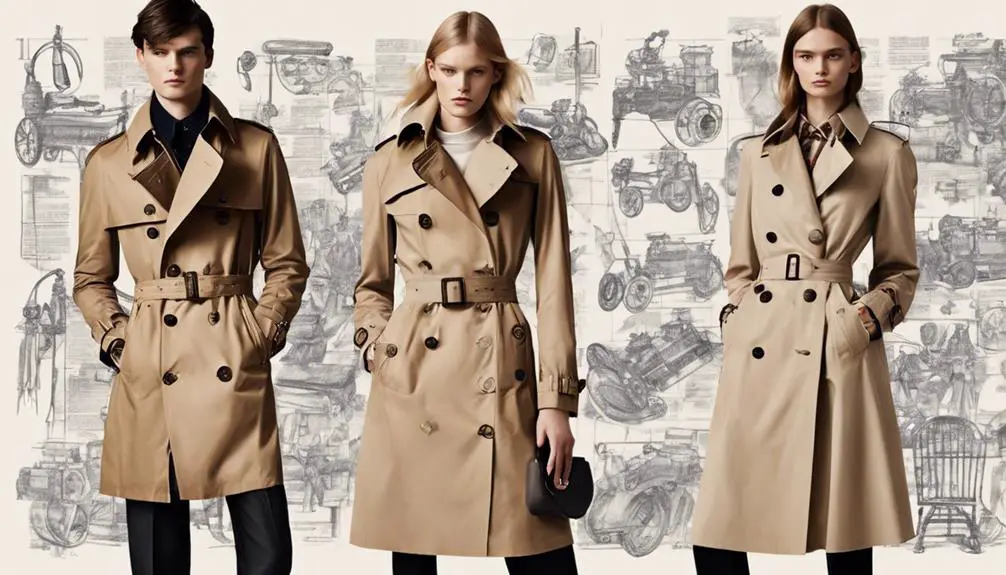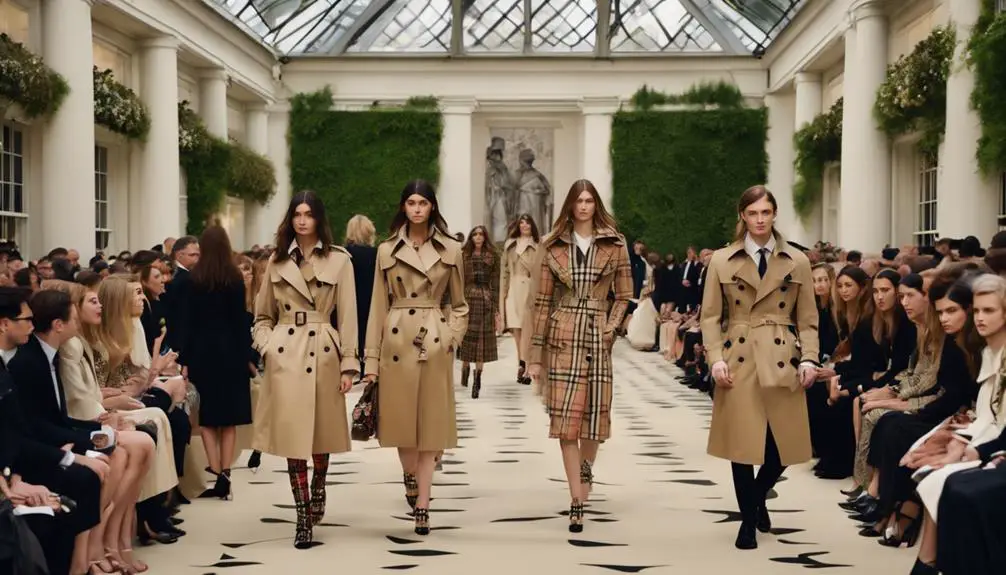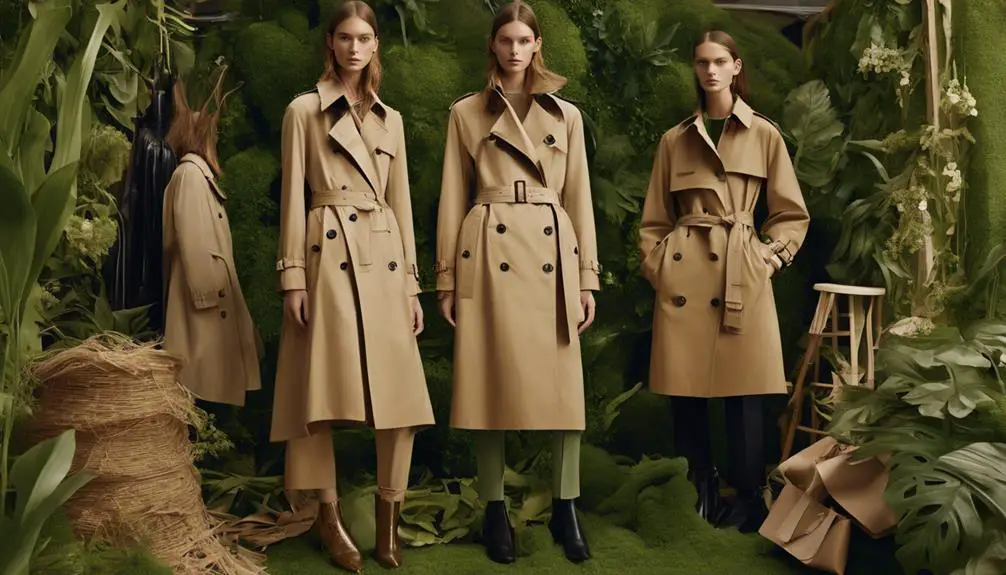The House of Burberry has had several famous moments since its founding in 1856. You'd find standout innovations like the invention of gabardine in 1879, which revolutionized weatherproof fabrics. During World War I, the brand created the iconic trench coat for soldiers. Royal endorsements, including a Royal Warrant from Queen Elizabeth II, solidified its reputation. Burberry also led in digital fashion by livestreaming shows and introducing the "See Now, Buy Now" model. Today, it champions sustainability through initiatives like the ReBurberry Fabric Initiative. There's so much more to uncover about this storied brand's influence and evolution in fashion.
Founding Innovations and Milestones

When you think about fashion's evolution, Burberry's founding innovations and milestones stand out as key moments in history. Thomas Burberry laid the groundwork for this iconic brand in 1856 in Basingstoke when he was just 21 years old. His vision focused on creating functional clothing that could withstand the unpredictable British weather, which was essential in the brand's early years.
This ambition led to the invention of gabardine in 1879, a lightweight and weatherproof fabric that transformed rainwear, making it a hallmark of Burberry's legacy. By 1888, Burberry patented this innovative material, marking a significant milestone in the fashion industry.
In 1901, the brand solidified its identity with the introduction of the equestrian knight logo, inspired by historical armor. This emblem reflected both strength and sophistication, adding to Burberry's allure.
Another major milestone occurred during World War I, when the trench coat was developed between 1914 and 1918. This garment featured practical elements designed for military use, quickly becoming a staple in Burberry's collection and later, a fashion icon, further emphasizing the brand's commitment to style and functionality.
Burberry's first London boutique opened in 1891, representing a pivotal shift from outdoor clothing to high fashion. This move not only broadened the brand's appeal but also set the stage for its enduring success in the fashion world.
Each of these innovations and milestones showcases how Burberry has remained at the forefront of style and functionality, shaping fashion history in remarkable ways, including its vintage clothing identification process.
Military Heritage and Exploration
How did Burberry become synonymous with military heritage and exploration? It all began during World War I when the Burberry trench coat was developed as part of the British Army uniform. This coat wasn't just stylish; it featured functional elements specifically tailored for military use. Its design became a staple for soldiers, offering protection and durability.
The connection to exploration blossomed with iconic figures like Sir Ernest Shackleton, who wore Burberry gabardine during his famous expeditions, including the notorious Endurance journey. Gabardine, known for its weatherproof qualities, proved essential in extreme conditions.
In fact, the first recorded polar explorer, Dr. Fridtjof Nansen, took Burberry gabardine with him to the Arctic Circle in 1893, showcasing how effective this fabric was.
Burberry's influence didn't stop there. Air Commodore Edward Maitland set a long-distance flight record in 1908 while wearing Burberry gabardine, further solidifying the brand's connection to adventure and exploration.
The company also sponsored the 1937 record-breaking flight from Croydon to Cape Town, featuring Burberry apparel and reinforcing its association with pioneering journeys.
From military trenches to polar explorations, Burberry has woven itself into the very fabric of adventure. Its commitment to producing reliable and stylish outerwear has made it a trusted name for those who dare to explore the extremes.
With a legacy like this, it's clear why Burberry stands tall in the domains of military heritage and exploration.
Royal Endorsements and Growth

Burberry's journey from military heritage and exploration seamlessly connects to its royal endorsements, which greatly elevated the brand's status. Receiving a Royal Warrant from HM Queen Elizabeth II in 1955 as a Weatherproofer was a monumental moment that remarkably enhanced Burberry's prestige. This recognition didn't stop there; in 1990, HRH The Prince of Wales granted Burberry another Royal Warrant as an Outfitter, solidifying its place among the British elite.
The brand's commitment to quality and craftsmanship is reminiscent of Calvin Klein's innovative product evolution, such as the introduction of iconic fragrances that showcased modern trends.
As you think about Burberry's impact, picture the following:
- Iconic trench coats that have graced royal events
- Elegant fabrics that embody British craftsmanship
- A legacy of coats exported globally, dominating the outerwear market
- A commitment to UK manufacturing, ensuring quality and authenticity
By 1965, Burberry accounted for one in five coats exported from Britain, showcasing its dominance in the outerwear market. The acquisition of the Castleford factory in 1972 further reinforced the brand's dedication to UK manufacturing and growth.
Meanwhile, Burberry's rebranding efforts in the late 1990s, including the shift from Burberrys to Burberry, marked a strategic move to modernize the brand while maintaining its royal connections.
These royal endorsements not only provided prestige but also fueled Burberry's growth, transforming it into a distinguished British brand revered worldwide. Today, when you think of Burberry, you can't help but envision a legacy intertwined with royalty and quality craftsmanship.
Digital Evolution and Modernization
In recent years, the digital environment has transformed how luxury brands connect with consumers, and Burberry has embraced this shift with remarkable agility. Back in 2010, Burberry made waves as the first luxury brand to livestream a fashion show, setting a new standard in digital marketing that many have since followed. This innovative approach didn't just stop there; in 2011, the brand shifted to a retail-focused distribution model, increasing direct-to-consumer sales from 43% to an impressive 64%.
Burberry took the digital evolution further by establishing a strong online presence. With the introduction of the "See Now, Buy Now" model in 2016, customers could purchase items immediately after runway shows, merging the excitement of fashion with instant gratification.
Fast forward to 2020, and Burberry showcased its adaptability by rolling out creative fashion films and digital presentations in response to the pandemic.
Additionally, Burberry has committed to innovation through partnerships like its collaboration with the Royal College of Art in 2017, focusing on sustainable materials. This reflects not only a modernization of their approach but also a desire for environmental responsibility.
The Burberry Foundation plays a role in these efforts, reinforcing the brand's dedication to a future that balances luxury with sustainability. With every leap into the digital domain, Burberry remains a leader, proving that luxury and innovation can go hand in hand.
Commitment to Sustainability and Ethics

A strong commitment to sustainability and ethics defines Burberry's modern identity. The brand isn't just about luxury; it's about making a positive impact on the world. You can see this through various initiatives that reflect their dedication to ethical fashion and the environment.
- The Burberry Material Futures Research Group, formed in 2017, collaborates with the Royal College of Art to innovate sustainable materials.
- In 2018, Burberry launched the Rainbow Vintage check collection, supporting LGBTQ+ organizations and championing inclusivity within its sustainability efforts.
- Partnering with the Ellen MacArthur Foundation, Burberry promotes a circular economy, focusing on reducing waste and encouraging responsible consumption.
- The ReBurberry Fabric Initiative, launched in December 2020, donates leftover fabrics to fashion schools across the UK, reinforcing their commitment to sustainable practices.
Burberry's journey toward sustainability isn't just a trend; it's part of their core values. Recognized in the Dow Jones Sustainability Index in 2016, they showcased a commitment to sustainable practices that distinguish them in the fashion industry.
By combining innovation and ethical practices, Burberry is leading the way toward a more sustainable future. They've set an example for others to follow, proving that luxury and responsibility can go hand in hand.
As they continue to evolve, you can expect Burberry to remain at the forefront of the sustainability movement, ensuring that their legacy reflects both quality and conscience.




I needed to post you a little bit of remark in order to say thank you yet again with your pleasing strategies you’ve discussed on this website. It was so generous with you to supply unreservedly precisely what numerous people could have offered for sale as an e-book to end up making some profit on their own, precisely since you could have tried it in the event you wanted. The concepts additionally acted to be a good way to know that some people have similar dream like my own to figure out a lot more in regard to this condition. I know there are millions of more enjoyable periods up front for folks who look into your site.